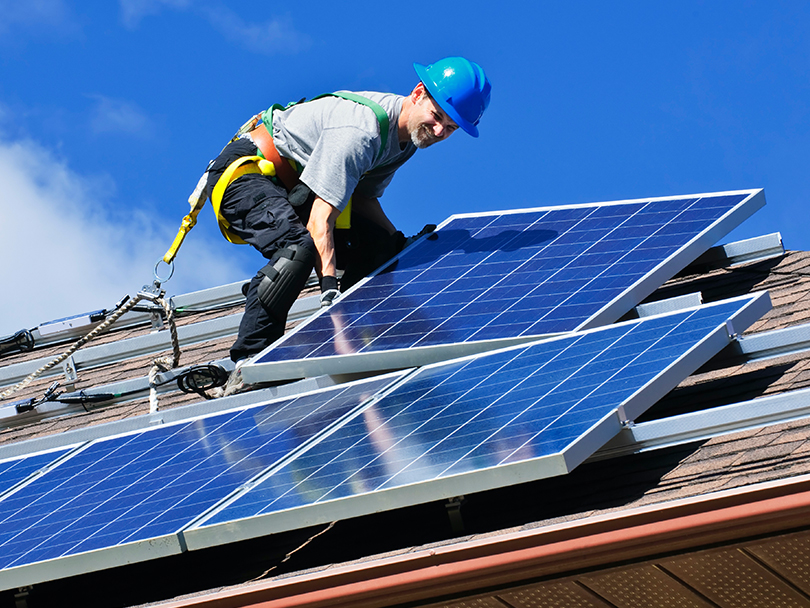By Amy Higgins
The sun has powered lives since our predecessors used glass to reflect the sun’s rays and create fire. Over the centuries, the sun’s power potential was further realized, altered and adapted to its present form where solar panels can convert sunlight into electricity. Today, people across the globe are installing residential solar systems to help run their homes; power their cars, devices, appliances, lighting and ventilation systems; and save money on energy costs.
However, solar energy terms and functions are sometimes confusing. And often, misinformation or misunderstanding can sway consumers about whether or not to harness solar energy at home.
THE INNER WORKINGS OF SOLAR
To shed a little light on residential solar, first think of its inner workings. Essentially, the solar systems seen on rooftops are made up of solar cells — also known as photovoltaic cells. These cells are constructed with semiconductor material, “semi” meaning the components’ response to the sun lands somewhere in between metal and an insulator. PV cells are connected with more PV cells to create modules. When the modules are joined together, you have a solar electric system. A typical residential rooftop solar system has approximately 30 modules, according to the U.S. Department of Energy.
According to the DOE, when the PV cells absorb sunlight, that energy becomes negatively charged particles called electrons. The cells contain additional layers that pull the current through the system’s grid-like metal contacts and send it to an inverter. The inverter takes the direct current energy and converts it to an alternating current that moves into the electric grid and the home’s electrical system.
IS ROOFTOP SOLAR RIGHT FOR YOU?
Residential solar may be attractive because of potential cost savings on electric bills. And according to NREL, a solar energy system that saves $200 on an annual electric bill can raise that home’s value by $4,000. With proper care, a good residential solar electric system can last more than 25 years.
Before you sign on the dotted line, schedule a consultation with the prospective solar installation company. This is typically free of charge and will help you better decide if solar is right for you. A few potential downsides to installing residential solar systems include:
The initial cost. According to Consumer Affairs, a residential solar system may cost from $10,000 to $30,000 or more and it typically takes five to 15 years to break even on installation costs.
It is essential to have an experienced professional install the system, as it is a complex process. This can be frustrating for determined DIYers, but improper installation can further strain a homeowner’s bank account to repair the system.
Your roof may not support the system because of age, wear and tear, or obstructions. Also, it’s best to have little or no shade on your rooftop, and the system should face south for optimal results.
WHAT HAPPENS ON A CLOUDY DAY?
Arguably the biggest drawback for installing a residential solar system is that it only generates power when the sun is shining. To alleviate this concern, consider installing a battery storage system that collects and stores solar energy on a sunny day and can then deliver power to your home on a cloudy day. According to the DOE, a solar-plus-storage system costs between $25,000 and $35,000; adding battery storage to an existing solar system costs between $12,000 and $22,000.
WHAT HAPPENS WHEN THE PANELS PRODUCE MORE ENERGY THAN I USE?
Another thing to keep in mind before going solar is net metering. What is net metering? Net metering is a mechanism that credits solar energy system owners for any excess power that is sent back to the electric grid. If the solar panels produce more electricity than the home needs, the consumer is compensated for that excess electricity. Contact your local electric cooperative to find out more about net metering and what it means for your specific situation.
BOTTOM LINE
Be sure to contact your electric cooperative before making the move to add solar. Lean on the knowledge of your cooperative’s professionals who can offer insight that can help you decide if investing in a residential solar system is right for you.
With the proper research and weighing all the pros and cons, you can make an informed decision on how best to harness the undeniable power of the sun. It may be installing a residential solar electric system; or it may just be a quiet afternoon just soaking up some rays.
Amy Higgins is a freelance writer who has reported on electric industry topics for more than a decade.
Click here to read Miranda Boutelle’s list of considerations before installing solar. Her list will help ensure you meet your money-saving and environmental goals.

